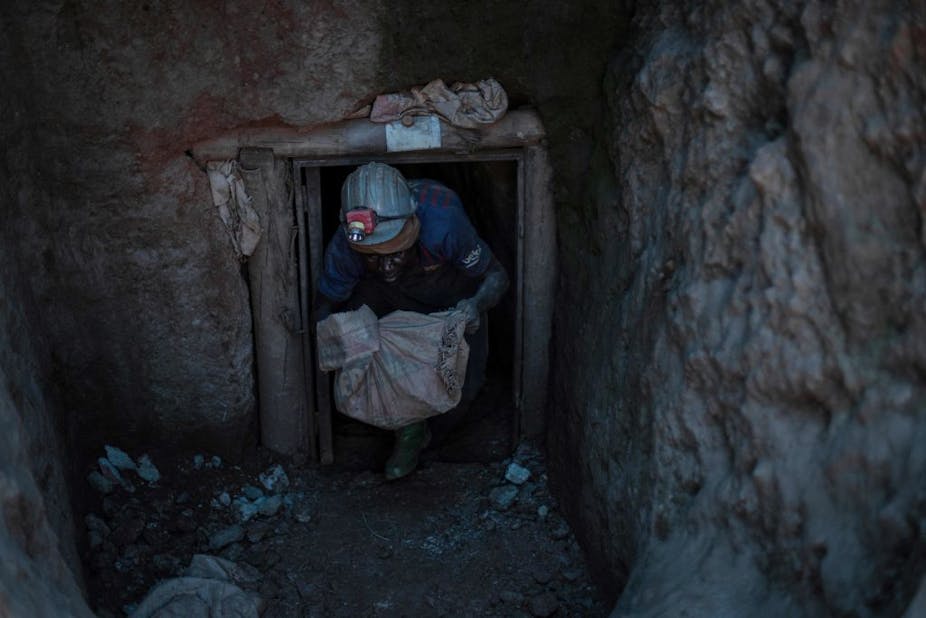Artisanal and small-scale mining in Africa has grown significantly in recent decades. Between 1999 and 2019, the estimated number of African miners engaged in this sector increased from two million to 10 million. Typically, it is much more labour intensive than large-scale mining, and the work more physically demanding.
Globally, between one-quarter and one-fifth of gold, diamond, tantulum, and tin is produced by this form of mining.
In Africa, artisanal and small-scale mining is widely perceived as a low productivity and subsistence activity. It is the common view of international financial institutions, international and African development agencies, and African governments that it should therefore make way for the superior expertise and efficiency of experienced multinational mining corporations. These corporations, it’s assumed, are much better equipped than African miners to drive economic growth and development.
From this perspective, the forced displacement of African miners to make way for industrial projects led by foreign mining corporates – as has taken place across the continent over the last few decades – is relatively unproblematic.
Yet this form of mining should not be so easily dismissed. I have investigated artisanal and small-scale gold mining in South Kivu Province of the Democratic Republic of the Congo (DRC). My research findings demonstrate that, contrary to popular perception, it is a mechanising form of production making significant contributions to development.
This aligns with the earlier work of the late Tanzanian academic and novelist Seithy Loth Chachage. In the 1990s he argued that small scale operations in Tanzania were innovating and stimulating local growth.
Over the last few decades, national and regional African mining policy has tended to constrain rather than encourage artisanal and small-scale mining. Instead, priority has been given to large-scale industrial mining. These findings challenge the wisdom of this approach.
Shift to mechanisation
The research was undertaken over an 18-month period during extended stays in two gold mining regions of South Kivu: Luhwindja and Kamituga. Gold mining in both areas dates back to the early twentieth century. Today, there are approximately 15,000 to 20,000 miners working informally across both sites. Since 2010, they have faced displacement and suppression to make way for industrial mining projects.
The miners are led by a dynamic managerial class composed of shaft managers and traders. They mobilise and organise workers in a wide array of different labour tasks. While the labour can be arduous, worker wages are significantly higher than locally available alternatives, and comparable to those earned in industrial mining.
The managerial class accrues sizeable profits, which its reinvests in land, property, livestock, and commerce. In addition, a significant share of profits is reinvested in production. This reinvestment stimulates productivity through a locally led process of mechanisation.
In the late 2000s, artisanal and small scale gold miners in Kamituga noticed a decrease in the quality of the extracted ore. In response, in November 2011, a Congolese trader brought three ball mills to Kamituga to break down large rocks. He had imported the mills from Tanzania at a cost of around US$7,000 each.
Shortly afterwards, a Congolese entrepreneur set up a ball mill repair workshop in Kamituga. Soon, the mills began to be manufactured locally. By the end of 2012 there were around 70 locally owned ball mills active across Kamituga.
Around the same time, shaft managers in the area were also attempting to respond to decreasing production by connecting sites to the local electricity grid. The aim was to enable production at deeper levels underground. In many cases, explosives were used alongside water and oxygen circulation machines, to blast through the hard rock encountered at these deeper levels.
Through the increased use of machinery, explosives, and ball mills, a mechanised and locally led form of production was beginning to emerge organically in the area. As a result, sites that had previously been exhausted by more purely artisanal techniques once again became productive.
Challenging the myths
The findings challenge one of the recurring arguments and policy recommendations from the African mining literature. Namely, that artisanal and small scale miners and industrial mining corporations are not in competition for the same deposits. The thinking is that small scale miners target easily accessible surface deposits while corporations target deeper veins that lie further underground. The conclusion is that governments should work to generate the conditions for their peaceful coexistence.
Yet one could also think of artisanal and small scale mining not as a low productivity, subsistence activity, but as a dynamic and mechanising form of production. This suggests these two distinct groups are in fact in more direct competition than academics and policy makers have allowed.
What a mining corporation exploits industrially today is nothing but the riches that, over a longer time frame, a mechanising artisanal and small scale mining sector could exploit tomorrow. This invites a reconsideration of the merits and consequences of the ‘coexistence’ argument.
Arguing that artisanal and industrial miners should coexist assumes that artisanal miners should stay artisanal. In this scenario, industrial miners would access the most prized and valuable deposits. Artisanal and small scale miners would be allocated whatever remains. This would both thwart their aspirations and limit the positive contribution the artisanal and small scale sector makes to development. It is time for a rethink.

